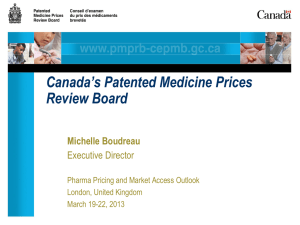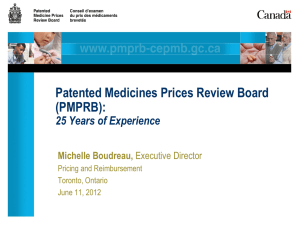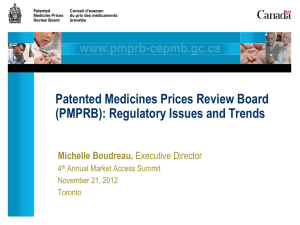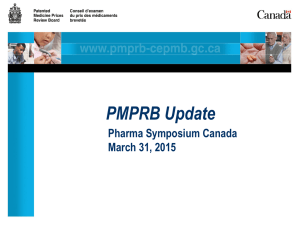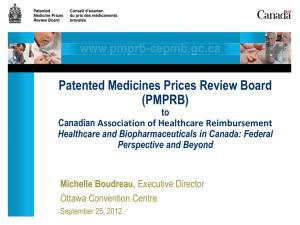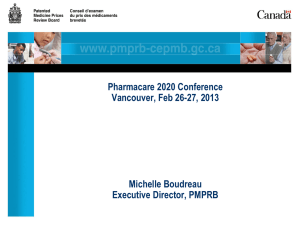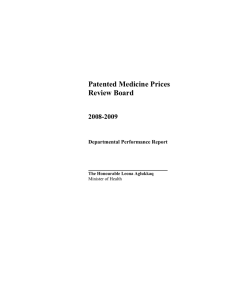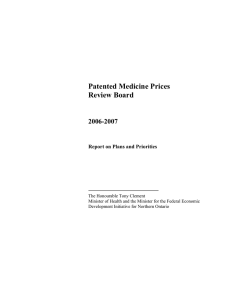Patented Medicine Prices Review Board 2009-2010
advertisement
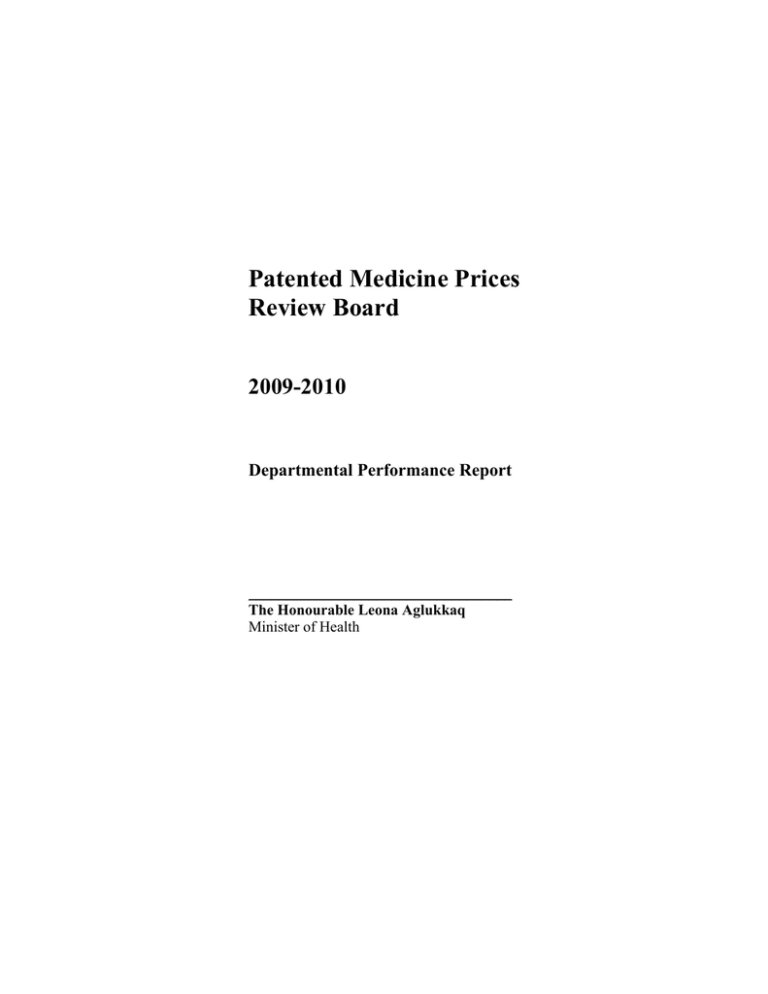
Patented Medicine Prices Review Board 2009-2010 Departmental Performance Report ___________________________________ The Honourable Leona Aglukkaq Minister of Health Table of Contents Vice-Chairperson’s Message.................................................................................... 5 Section I — Board Overview ................................................................................... 7 Raison d’être and Responsibilities .................................................................................. 7 Strategic Outcome and Program Activity Architecture................................................ 9 Performance Summary .................................................................................................. 10 Financial Resources ....................................................................................................... 10 Human Resources .......................................................................................................... 10 Performance Summary Table ........................................................................................ 11 Contribution of Priorities to Strategic Outcome ............................................................ 12 Risk Analysis ................................................................................................................... 16 Expenditure Profile......................................................................................................... 18 Voted and Statutory Items ............................................................................................. 20 Section II— Analysis of Program Activities by Strategic Outcome ........ 21 Strategic Outcome........................................................................................................... 21 Program Activities .......................................................................................................... 22 Section III — Supplementary Information ...................................................... 27 Financial Highlights ........................................................................................................ 27 Supplementary Information Tables .............................................................................. 29 Other Items of Interest ................................................................................................... 29 Vice-Chairperson’s Message I am pleased to present the 2009-2010 Departmental Performance Report for the Patented Medicine Prices Review Board (PMPRB). The PMPRB is an independent, quasi-judicial body established by Parliament in 1987 under the Patent Act. Its mandate is two-fold: Regulatory ⎯ to ensure that prices charged by patentees for patented medicines sold in Canada are not excessive; and Reporting ⎯ to report on pharmaceutical trends of all medicines, and on R&D spending by patentees. The PMPRB contributes to the broader objective of improving the health of Canadians by protecting consumers and the Canadian health care system from excessive patented drug prices and by contributing to informed drug policy decision-making. In 2009 there were 1,177 patented drug products under the Board’s jurisdiction, including 81 new patented drugs reported that year. The PMPRB’s capacity to carry out its regulatory mandate is dependent on relevant and effective Guidelines and on the ability to conduct hearings, when required. In 2005, the Board initiated a process to review its Guidelines, which included extensive consultations with all interested stakeholders. In March 2009, the final round of consultations took place with the release of the Notice and Comment — Draft Revised Excessive Price Guidelines, which resulted in 31 written submissions and numerous bilateral and multilateral stakeholder follow-up consultations. As a direct result of input received through this process, the Board made its final decisions and released its new Compendium of Policies, Guidelines and Procedures on June 9, 2009. Following the publication, Board Staff held several outreach sessions in Toronto and Montreal to assist patentees in better understanding the changes and preparing for implementation. The Board’s new Guidelines came into effect on January 1, 2010. Moving forward, Board Staff will be monitoring and evaluating the application and impact of key changes to the Guidelines to ensure that they remain relevant and appropriate in the modern pharmaceutical environment. New funding approved in 2008-2009 has enabled the Board to complete its Guidelines review; provide educational outreach to patentees and other stakeholders; begin implementation and monitoring of the new Guidelines; carry out ongoing price reviews and investigations within reasonable timelines; and hold timely hearings, as required. In 2009-2010, the Board issued two Notices of Hearing, the first into the matter of Amgen Canada Inc. and the price of the medicine Neulasta; and the second into the matter of Sandoz Canada Inc. In 2009, the PMPRB pursued its partnership with the Canadian Institute on Health Information, Health Canada, and participating provincial and territorial public drug plans, ________________________________________________________________________ Vice-Chairperson’s Message 5 through our collaboration on the National Prescription Drug Utilization Information System, refining our goals and providing in-depth analysis and advice. Through this work, the Board helps fill information gaps and assists policy makers to better understand trends in drug prices and the factors influencing drug costs in Canada. The PMPRB remains committed to predictability, fairness and transparency in the fulfilment of its regulatory and reporting responsibilities, to ongoing engagement with its key stakeholders, and to continual monitoring of developments within the larger pharmaceutical environment that may relate to, or impact upon, the conduct of the Board’s mandate. Mary Catherine Lindberg Vice-Chairperson ________________________________________________________________________ 6 Patented Medicine Prices Review Board Section 1 — Board Overview Raison d’être and Responsibilities The Patented Medicine Prices Review Board (PMPRB) is an independent, quasi-judicial body created by Parliament as a result of revisions to the Patent Act (Act) in 1987 (Bill C-22). The Act was further amended in 1993 (Bill C-91). The revisions were intended to balance the extension of patent protection with the need to protect consumers from possible excessive patented drug prices. The PMPRB has a dual role: Regulatory ⎯ To ensure that prices charged by patentees for patented medicines sold in Canada are not excessive. Reporting ⎯ To report on pharmaceutical trends of all medicines, and on R&D spending by pharmaceutical patentees. Regulatory Role The PMPRB is responsible for regulating the factory-gate prices that patentees charge for prescription and non-prescription patented drug products sold in Canada to wholesalers, hospitals, pharmacies or others, for human and veterinary use, to ensure that they are not excessive. The PMPRB regulates the price of each patented drug product (each strength of an individual, final dosage form of a drug). This is normally the level at which Health Canada assigns a Drug Identification Number (DIN) as part of the Notice of Compliance process. However, the Board’s mandate also includes drug products available under the Special Access Programme; drug products available through a Clinical Trial Application; and Investigational New Drug Products. The Federal Court of Appeal articulated the legal requirement as to when a patent will “pertain” to the medicine. In this regard, the Court established the “merest slender thread” requirement, which is wide in scope. The Board’s jurisdiction is not limited to drug products for which the patent is on the active ingredient. Rather, the Board’s jurisdiction also covers drug products for which the patents relate, but are not limited, to the processes of manufacture, the delivery system, dosage form, indication/use, and/or any formulation. Patented drug products are not limited to brand name drug products. A number of generic companies fall under the Board’s jurisdiction by virtue of being licensees (i.e. authorized to sell the same drug product as the brand company is selling) or due to their own patents (e.g. related to processes of manufacture). The PMPRB has no authority to regulate the prices of non-patented drug products and does not have jurisdiction over prices subsequently charged by wholesalers or retailers or over pharmacists’ professional fees. In addition, matters such as whether drugs are ________________________________________________________________________ Section I — Board Overview 7 reimbursed by public drug plans, distribution channels and prescribing are outside the purview of the PMPRB. Under the Act, patentees are required to inform the PMPRB of their intention to sell a new patented drug product. Upon the sale of such a patented drug product, as per the Patented Medicines Regulations, patentees are required to file price and sales information for the first day’s sales and, thereafter, twice a year for six month periods (January to June and July to December) for each strength of each dosage form of each patented drug product sold in Canada for price review/regulation purposes, for the duration of the patent(s). Although patentees are not required to obtain the PMPRB’s approval of the price of a patented drug product before it is sold, they are required to comply with the Act to ensure that prices of patented drug products sold in Canada are not excessive. If a patented drug product is sold before the patent issues, the PMPRB will review the price of the product as of date of first sale, as long as this is after the date on which the patent application was laid open for public inspection. In the event that the Board finds, after a public hearing, that a price is or was excessive in any market, it may order the patentee to reduce the price and take measures to offset any excess revenues it may have received. Reporting Role The PMPRB reports annually to Parliament, through the Minister of Health, on its activities, on pharmaceutical trends relating to all patented drug products, and on the R&D spending by pharmaceutical patentees. In addition to these reporting responsibilities, under section 90 of the Act, the Minister of Health has the authority to direct the PMPRB to inquire into any other matter. Under this provision, the Minister has directed the Board to undertake two initiatives: the National Prescription Drug Utilization Information System (NPDUIS), and monitoring and reporting on Non-Patented Prescription Drug Prices (NPPDP). National Prescription Drug Utilization Information System (NPDUIS) Since 2001, pursuant to an agreement by federal, provincial and territorial Ministers of Health, the PMPRB has been conducting research under the NPDUIS initiative. The purpose of the NPDUIS is to provide critical analyses of price, utilization and cost trends so that Canada´s health system has more comprehensive and accurate information on how prescription drugs are being used and on sources of cost drivers. Non-Patented Prescription Drug Prices (NPPDP) In 2005, the Minister of Health, on behalf of federal, provincial and territorial Ministers of Health, directed the PMPRB to monitor and report on non-patented prescription drug prices. This function is aimed at providing a centralized credible source of information on non-patented prescription drug prices. Since April 2008, NPPDP studies are conducted under the umbrella of the NPDUIS initiative. ________________________________________________________________________ 8 Patented Medicine Prices Review Board Strategic Outcome and Program Activity Architecture The PMPRB has one Strategic Outcome (SO) and three program activities (PAs), which are illustrated in the following chart: Strategic Outcome Canadians and their health care system are protected from excessive pricing for patented medicines sold in Canada and are informed on pharmaceutical trends. Program Activities Compliance and enforcement of non-excessive pricing for patented medicines Pharmaceutical trends Internal services Compliance and enforcement of non-excessive pricing for patented medicines The Patented Medicine Prices Review Board (PMPRB) is responsible for regulating the prices that patentees charge for patented drugs sold in Canada to wholesalers, hospitals, pharmacies or others, for human and veterinary use. Through this program activity, the PMPRB reviews the prices that patentees charge for patented drugs, based on the price review factors in the Patent Act, to ensure that these prices are not excessive. In the event that the Board finds, following a public hearing, that a price is excessive in any market, it may order the patentee to reduce the price and take measures to offset any excess revenues it may have received as a result of excessive prices. Pharmaceutical trends Through this program activity, the PMPRB provides analysis of pharmaceutical price trends and research and development spending by pharmaceutical patentees. It also provides critical analyses of price, utilization and cost trends for prescription drugs, and information on non-patented prescription drug prices. The PMPRB reports on this information and its price review and enforcement activities as they relate to excessive pricing for patented medicines, both annually to Parliament, through the Minister of Health, and through special published studies. Internal Services Internal Services are groups of related activities and resources that are administered to support the needs of programs and other corporate obligations of an organization. These groups are: Management and Oversight Services; Communications Services; Legal Services; Human Resources Management Services; Financial Management Services; Information Management Services; Information Technology Services; Real Property Services; Materiel Services; Acquisition Services; and Travel and Other Administrative Services. Internal Services include only those activities and resources that apply across an organization and not to those provided specifically to a program. ________________________________________________________________________ Section I — Board Overview 9 Performance Summary 2009-2010 Financial Resources ($ thousands) Planned Spending $11,358.0 Total Authorities $11,952.8 Actual Spending $9,099.8 2009-2010 Human Resources (FTEs) Planned 76 Actual 53 Difference 23 During 2009-2010, the PMPRB completed the revision of its Guidelines to better deal with new forms of incremental pharmaceutical innovation and made significant progress in maintaining the timeliness of ongoing price reviews and investigations; addressing workload increases and replacing its data management system. Differences in spending between the 2008-2009 and 2009-2010 reporting periods are due to a slight increase in expenditures on hearings, significant investment in information technology and significant progress in staffing new positions. Of the total authorities of $11.9 million, $2.5 million resides in a Special Purpose Allotment dedicated to external costs of public hearings (legal counsel, expert witnesses etc.). In the 2009-2010 year, $1.3 million was expended on hearings. Remaining unused amounts cannot be reallocated and are returned to the Consolidated Revenue Fund (CRF). These funds were revised due to the fact that some ongoing hearings were settled when patentees unexpectedly submitted Voluntary Compliance Undertakings (VCUs), while other matters that were anticipated to be recommended to move to a hearing were delayed as a result of further discussions with patentees. During 2009-2010, the PMPRB staffed 80% of the new positions funded through the receipt of permanent funding in 2008-2009. However, the majority of appointments were made in the last quarter of the fiscal year, resulting in a lapse in salary of $1.4 million. ________________________________________________________________________ 10 Patented Medicine Prices Review Board Performance Summary Table ($ thousands) Strategic Outcome: Canadians and their health care system are protected from excessive pricing for patented medicines sold in Canada and are informed on pharmaceutical trends. Performance Indicator Canada’s prices on average are in line with the seven comparator countries listed in the Regulations. Target Canada’s prices on average are at or below the median of international prices. 2009-2010 Performance In 2009, Canada’s prices were on average slightly higher than the median of international prices. Further information is available in the PMPRB’s Annual Report 2009, Figure 12, at http://www.pmprbcepmb.gc.ca/English/View.asp?x=91&mp=68 Alignment to Government of Canada Outcomes: Both Program Activities 1 and 2 align to the Healthy Canadians outcome. Program Activity 2008-2009 Actual Spending 2009-20101 Main Estimates Planned Spending Total Authorities2 Actual Spending2 PA 1: Compliance and enforcement of non-excessive pricing for patented medicines $5,263.1 $7,045.0 $7,045.0 $6,929.9 $4,724.2 PA 2: Pharmaceutical trends $2,787.1 $1,593.0 $1,593.0 $1,451.8 $670.7 N/A $2,720.0 $2,720.0 $3,571.1 $3,704.9 $11,358.0 $11,358.0 $11,952.8 $9,099.8 PA 3: Internal services Total 1 2 $8,050.2 Commencing in the 2009-2010 Estimates cycle, the resources for Program Activity: Internal Services is displayed separately from other program activities; they are no longer distributed among the remaining program activities, as was the case in previous Main Estimates. This has affected the comparability of spending and FTE information by Program Activity between fiscal years. Total Authorities and Actual Spending have been adjusted to reflect the Employee Benefit Plan (EBP) within the Internal Services Program Activity, as per the Public Accounts; and prejudgment and postjudgment interest in the amount of $169,500 thousand, as per the Order of the Federal Court in the matter of Teva Neuroscience G.P.-S.E.N.C. v. Attorney General of Canada 2009FC1206. ________________________________________________________________________ Section I — Board Overview 11 Contribution of Priorities to Strategic Outcome Operational Priorities Operational Priority: Strengthen policy and economic analysis. Type: Ongoing Status: Met All In 2009-2010, the PMPRB successfully completed a comprehensive review and modernization of its Guidelines, which culminated in the publication and implementation of the Board’s Compendium of Policies, Guidelines and Procedures. As part of its ongoing commitment, the PMPRB has begun actively monitoring the implementation of the new Guidelines to ensure that the desired outcomes are being achieved, as well as to assess the impacts on Canadian price trends. The PMPRB initiated staffing processes in the Policy and Economic Analysis Branch in order to increase its capacity to monitor and assess the impact of legislative, regulatory and policy changes, both in Canada and in other countries, as well as changes in the pharmaceutical industry. Linkages to Strategic Outcome3: Strengthening policy and economic analysis will ensure that the PMPRB’s regulatory activities remain relevant, appropriate and effective, thereby protecting Canadians and their health care system from excessive prices. Further progress towards achieving this priority is expected in 2010-2011. Operational Priority: Improve the timeliness of ongoing price reviews and investigations. Type: Ongoing Status: Met All The membership of the Human Drug Advisory Panel (HDAP) was expanded from three to six members. This will permit a wider scope of expertise in terms of the new levels of therapeutic improvement in the new Guidelines, in particular the new consideration of secondary factors. The PMPRB undertook to recruit an external candidate to increase scientific capacity. 3 The PMPRB has only one Strategic Outcome (SO), and all priorities are linked to that SO. ________________________________________________________________________ 12 Patented Medicine Prices Review Board The PMPRB held six outreach sessions with patentees to explain the regulatory reporting requirements and application of the new Guidelines. In addition, Staff of the Board participated in four outreach sessions organized by other organizations. The PMPRB improved the timeliness of the price review of existing patented drug products. Compliance reports were completed and sent to patentees within one month of patentees’ filing of semi-annual data. Linkages to Strategic Outcome: Timely review of patented drug prices to ensure they are not excessive is key to protecting consumer interests. Operational Priority: Hold efficient hearings into excessive prices as required. Type: Ongoing Status: Met All In 2009-2010, four new matters were referred to the Chair for issuance of a Notice of Hearing (NOH). Two NOHs have been issued while two others are still pending. Three hearings were completed — decisions issued and filed with the Federal Court; decisions are pending in 3 cases, while 4 other matters are ongoing. The PMPRB met its commitment to improve capacity in the legal services and registrar areas. Linkages to Strategic Outcome: The ability to hold public hearings when required is a core component of the Board’s mandate and authority. As a quasi-judicial body, the PMPRB must have the capacity to give patentees a fair and timely hearing, thereby ensuring that the prices of patented medicines are not excessive. Operational Priority: Enhance the relevance and timeliness of analytical studies under NPDUIS. Type: Ongoing Status: Somewhat met The PMPRB made some progress towards strengthening internal capacity by staffing ________________________________________________________________________ Section I — Board Overview 13 vacant positions. However, as a small agency with a rather specialized mandate, the PMPRB continues to face a challenge in recruiting and retaining economists with the required knowledge and experience. Staffing vacant positions therefore remains a priority for 2010-2011. The PMPRB ensured that the research priorities and results were relevant and timely by holding a priority-setting exercise with members of the NPDUIS Steering Committee in May 2009, and subsequently providing progress updates through regular meetings and teleconferences of the NPDUIS Steering Committee throughout 2009-2010. Linkages to Strategic Outcome: Research and analysis conducted by the PMPRB contributes to the strategic outcome of ensuring that Canadians and their health care system are informed on pharmaceutical trends. Management Priorities Management Priority: Renew the database which stores and manipulates pricing data. Type: Ongoing Status: Met All Significant effort was dedicated to re-programming the mission-critical database to accommodate price test changes required to meet immediate business requirements related to the revised Guidelines. The multi-year project to re-develop the database using a newer technology is on target and progressing well. The base architecture for the system has been built and prototyping has commenced. Linkages to Strategic Outcome: The database housing all of the price, revenue and sales data for the nearly 1,200 drug products under the PMPRB’s jurisdiction is critical to the conduct of regulatory activities. The application manipulates data to perform the price tests that allow the PMPRB to effectively carry out its price regulatory mandate. The re-development project is expected to result in greater ease of use; enhanced security and second language capabilities; reduced maintenance costs; and greater flexibility to effect future changes needed to maintain and periodically upgrade the database. ________________________________________________________________________ 14 Patented Medicine Prices Review Board Management Priority: Implement Human Resources Plans. Type: Ongoing Status: Met All During 2009-2010, the PMPRB focused efforts on increasing the capacity of the organization by staffing new positions in all Branches. Some internal reallocations were made to address workload demands in Human Resources and to allow HR staff to better support critical program activities. Between April 2009 and March 2010, the PMPRB staffed 31 positions, including 80% of the new positions created as a result of the additional permanent funding. Development of learning plans has been integrated into the annual performance review discussions. Linkages to Strategic Outcome: Staffing of key positions has allowed the PMPRB to increase scientific and economic analysis capacity, better support hearings and investigations, and enhance stakeholder communications. ________________________________________________________________________ Section I — Board Overview 15 Risk Analysis As a quasi-judicial tribunal, the PMPRB’s capacity to carry out its statutory regulatory mandate is focused on its ability to issue appropriate and effective Guidelines and to conduct timely price reviews, investigations and, when needed, hearings. In 2005-2006, the PMPRB identified a risk to its Compliance and Enforcement Program Activity stemming largely from an unprecedented number of investigations and hearings into excessive drug prices. This prompted the Board to initiate a comprehensive review of and stakeholder consultation on its Guidelines to ensure the effectiveness, fairness, transparency and predictability of the price review process; and to conduct an A-base review to determine resource levels required to carry out its statutory regulatory mandate. In recognition of increasing workload pressures, the PMPRB received temporary program integrity funding in 2006-2007 and 2007-2008 and permanent funding in 20082009 to enable the organization to continue activities critical to the delivery of its regulatory mandate, including the Guidelines Review. The 2009-2010 Report on Plans and Priorities identified operationalization and impact of the revised Guidelines as a key risk. Consultations related to the Guidelines highlighted a number of issues of concern to industry, governments, private payers, consumer groups and others. As a result, the revised Guidelines implemented in January 2010 involved a number of changes to modernize the approach to reviewing patented drug prices. Additional resources were allocated to perform price reviews that confirm whether a price appears to be non-excessive under the Guidelines. Resources were also allocated to enhance educational outreach to assist patentees in proper filing. In addition, a Verification Tool was developed to enable patentees to receive timely feedback in order to correct any errors in data filing. The number of members of the Human Drug Advisory Panel was increased to accommodate the need to assess therapeutic evidence according to new patient-oriented secondary factors added to the revised Guidelines. Workload pressures will likely continue due to increasingly complex price reviews, investigations and hearings as arguments related to moderate therapeutic improvements, variable market prices, and the existence of customer benefits are raised and as jurisdictional challenges remain. These areas are being closely monitored and assessed, with adjustments being made in capacity and process as required. In addition, as decisions are issued by Board hearing panels and by the Courts as a result of Judicial Reviews of Board decisions, it will be essential to determine their broader policy impact and the potential need to further amend the Guidelines to ensure they are consistent with emerging jurisprudence. The PMPRB’s second program is Reporting — producing analyses and reports on pharmaceutical trends. The 2009-2010 Report on Plans and Priorities indicated that there ________________________________________________________________________ 16 Patented Medicine Prices Review Board was a risk that “studies may not be sufficiently timely or the conclusions readily pertinent to address the needs of federal/provincial/territorial drug plan decision-makers.” In order to address this risk, the PMPRB met with members of the NPDUIS Steering Committee in May 2009 to engage in a priority-setting exercise. This resulted in the identification of three priority areas for future research and the development of related project proposals. In addition, Steering Committee members were provided with regular progress updates (via quarterly teleconferences and biannual meetings) to ensure that projects remained on track. The PMPRB also improved its internal project management processes. The 2009-2010 Report on Plans and Priorities also identified a key challenge related to human resources, indicating that it would be essential to ensure that human resource planning and business planning remained in alignment and that operational staffing activity and other support services were equipped to support the evolving organizational needs and directions. In 2009-2010 the PMPRB reallocated funds to increase capacity in Human Resources to better support business requirements. Between April 2009 and March 2010, the PMPRB staffed 31 positions, including 80% of the new positions created as a result of the additional permanent funding. The integrated business and human resources planning framework continues to ensure the identification, review and documentation of human resources requirements on a quarterly basis. ________________________________________________________________________ Section I — Board Overview 17 Expenditure Profile In recognition of increasing workload pressures, the PMPRB was provided program integrity funding in the amounts of $4.9 million (excluding employee benefit plans (EBP)) for 2006-2007 and $5.0 million (including EBP) for 2007-2008 from the Treasury Board Risk Management Reserve to augment its $5 million A-base budget. In anticipation of the sunsetting of the program integrity funding at the end of March 2008, the PMPRB prepared a business case which identified ongoing funding pressures. Treasury Board Submission 834516, approved in September 2008, gave the PMPRB the authority to include an item in the Supplementary Estimates B in the amount of $4.7 million (excluding EBP), in addition to the core A-base of $5.8 million, to enable the PMPRB to meet its workload pressures and continue ongoing initiatives related to the delivery of its mandate. Reference levels were increased in Vote 35 (Program expenditures) by $5.6 million for 2009-2010, $6.2 million for 2010-2011, and $5.8 million for 2011-2012 and future years (including EBP and excluding Public Works and Government Services Canada accommodation charges). As part of these increased resources, authority was given to increase the Special Purpose Allotment to conduct Public Hearings, in Vote 35 (Program expenditures) by $1.9 million in 2008-2009, $2.2 million in 2009-2010, $2.8 million in 2010-2011, and $2.8 million in 2011-2012 and future years for public hearings and legal costs. The amounts related to external hearing costs (legal counsel, expert witnesses, etc.) are placed in a Special ________________________________________________________________________ 18 Patented Medicine Prices Review Board Purpose Allotment so that they are reserved strictly for that purpose. Any unspent amount is returned to the Consolidated Revenue Fund (CRF). In 2009-2010, the PMPRB is reporting expenditures of $9.1 million. Hearing expenditures have risen each year from 2007-2008 to 2009-2010, but there were fewer hearings than anticipated in 2009-2010 due in part to the submission of VCUs. In 2009-2010, the PMPRB staffed 80% of the new recently-funded new positions. However mid- and late-year start dates resulted in a $1.4 million lapse in salaries. ________________________________________________________________________ Section I — Board Overview 19 Voted and Statutory Items ($ thousands) Vote Number or Statutory Item (s) 35 (S) (S) (S) Truncated Vote or Statutory Wording Program expenditures Contributions to employee benefit plans Crown Liability and Proceedings Act4 Surplus Crown Asset Total PMPRB 2007-2008 Actual Spending 2008-2009 Actual Spending 2009-2010 Main Estimates 2009-2010 Actual Spending4 $6,722.5 $7,385.9 $10,369.0 $8,128.1 $709.9 $664.3 $989.0 $801.5 - - - $169.5 - - - $0.8 $7,432.4 $8,050.2 $11,358.0 $9,099.9 Treasury Board approved authority to increase reference levels in Vote 35 (Program expenditures) by $4.7 million (excluding EBP) for 2008-2009 and $5.6 million for 20092010. This funding is allowing the PMPRB to: 1) hold necessary hearings into excessive prices in a timely manner, as required by the Patent Act; 2) address the increase in workload anticipated as significantly more patented drug products come under its jurisdiction; 3) modernize its Guidelines, to better deal with new forms of incremental pharmaceutical innovation; 4) replace its outdated data management system, which houses and manipulates all of the confidential sales and price information filed by patentees; 5) strengthen its policy and economic analysis capacity to better anticipate and respond to emerging and evolving developments in the regulatory environment and the pharmaceutical sector; and 6) maintain the timeliness of ongoing price reviews and investigations. Differences in spending between the 2008-2009 and 2009-2010 reporting periods are due to a slight increase in expenditures on hearings, significant investment in information technology and significant progress in staffing new positions. 4 Actual Spending has been adjusted to reflect the EBP within the Internal Services Program Activity, as per the Public Accounts; and prejudgment and postjudgment interest in the amount of $169,500, as per the Order of the Federal Court in the matter of Teva Neuroscience G.P.-S.E.N.C. v. Attorney General of Canada 2009FC1206. ________________________________________________________________________ 20 Patented Medicine Prices Review Board Section II — Analysis of Program Activities by Strategic Outcome Strategic Outcome The Patented Medicine Prices Review Board (PMPRB) has one Strategic Outcome (SO): Canadians and their health care system are protected from excessive pricing for patented medicines sold in Canada and are informed on pharmaceutical trends. The performance indicator for the strategic outcome is: Canada's prices on average are in line with the seven comparator countries listed in the regulations. The target for the strategic outcome is: Canada's prices on average are at or below the median of international prices. The strategic outcome is supported by three Program Activities (PA): 1. Compliance and enforcement of non-excessive pricing for patented medicines; 2. Pharmaceutical trends; 3. Internal services. ________________________________________________________________________ Section II — Analysis of Program Activities by Strategic Outcome 21 Program Activities Program Activity 1: Compliance and enforcement of non-excessive pricing for patented medicines 2009-2010 Financial Resources ($ thousands) 2009-2010 Human Resources (FTEs) Planned Spending Total Authorities5 Actual Spending5 Planned Actual Difference $7,045.0 $6,929.9 $4,724.2 45 31 14 Expected Result Prices charged by patentees for patented medicines in Canada are not excessive according to the factors of the Patent Act. Performance Indicator Percentage of patented medicines that are within the Guidelines Target 95% of patented medicines are within the Guidelines. Performance Status Mostly met Performance Summary The prices of 89.7% of patented medicines were within the Guidelines. 5 Total Authorities and Actual Spending have been adjusted to reflect the EBP within the Internal Services Program Activity, as per the Public Accounts; and prejudgment and postjudgment interest in the amount of $169,500, as per the Order of the Federal Court in the matter of Teva Neuroscience G.P.-S.E.N.C. v. Attorney General of Canada 2009FC1206. ________________________________________________________________________ 22 Patented Medicine Prices Review Board Performance Analysis In 2009, Board Staff completed the review of the prices of 97.6% of patented drug products sold in Canada to determine conformity with the Board’s Guidelines. Of the 1,177 patented drug products under the Board’s jurisdiction, the prices of 89.7% were not excessive, 2.4% were under review, 7.6% were under investigation, and 0.3% were before a Board hearing. The overall level of compliance with the Board’s Guidelines has been declining in recent years (down from 95% in 2003 and 2004). The total number of investigations has been over 100 since 2007. Between January 1, 2009 and May 31, 2010, the PMPRB issued two Notices of Hearing. In the same period, 14 Voluntary Compliance Undertakings (VCU)6 were approved, three of which involved drug products that had been the subject of a Notice of Hearing. Given that the Board’s Guidelines are the main tool to communicate the Board’s interpretation of the appropriate approach and methodology to give effect to its statutory mandate, the exercise to review the Guidelines has been critical. Following extensive and iterative input from all key stakeholders and detailed deliberations by the Board, the revised Guidelines (released in June 2009 and implemented on January 1, 2010) provide more clarity and transparency on the review process and create the potential for flexibility in unique situations likely to arise in today’s pharmaceutical environment. The PMPRB will undertake an evaluation of the application and impact of the changes made to the Guidelines. It is hoped that, in the longer term, patentees will increase their compliance with the Guidelines. Lessons Learned Patentees’ willingness and ability to comply with the Board’s Guidelines are influenced by the larger pharmaceutical and industrial environment. The PMPRB noted, as part of its Guidelines review, that there have been fewer breakthrough/blockbuster new drugs in recent years, with instead an increasing trend toward incremental innovation that may not increase efficacy but may provide other benefits. There has also been a trend toward more globalization in drug pricing. Many of these recent developments were the subject of extensive discussion and stakeholder input as part of the Guidelines review. The Board believes that the revised Guidelines are more appropriate in that they recognize some of these recent trends but also anticipate a range of drug product pricing situations. Benefits for Canadians Ensuring that the average net prices of patented drug products sold in Canada are not excessive contributes to the protection of the interests of Canadians and the Canadian health care system. 6 A Voluntary Compliance Undertaking (VCU) is a written undertaking by a patentee to adjust the price of a patented drug product to conform to the Guidelines and to offset excess revenues. ________________________________________________________________________ Section II — Analysis of Program Activities by Strategic Outcome 23 Program Activity 2: Pharmaceutical trends 2009-2010 Financial Resources ($ thousands) 2009-2010 Human Resources (FTEs) Planned Spending Total Authorities7 Actual Spending7 Planned Actual Difference $1,593.0 $1,451.8 $670.7 13 5 8 Expected Result Stakeholders are more aware of pharmaceutical trends and cost drivers. Performance Indicators 1. Number of requests for PMPRB publications 2. Number of events where the PMPRB participates Target 1. 5% increase in requests over previous year 2. 10 events per year Performance Status 1. Mostly met 2. Exceeded Performance Summary The number of requests for PMPRB publications has remained relatively stable over the last few years. The PMPRB participated in 28 events. Performance Analysis The number of requests for PMPRB publications remained stable over the last few years. The PMPRB continued to focus its efforts on increasing the visibility of its Web site and initiated a review of the Web site, including a monitoring system to measure access to 7 Total Authorities and Actual Spending have been adjusted to reflect the EBP within the Internal Services Program Activity, as per the Public Accounts. ________________________________________________________________________ 24 Patented Medicine Prices Review Board Web pages. All PMPRB publications are posted on the Web. Subscriptions to its EBulletin are sought through, for example, the PMPRB’s quarterly publication. Its visibility and public awareness also continued to increase through, in part, the five-yearlong consultation on the review of the Board’s Guidelines which was completed with the implementation of the new Guidelines in 2010. Those consultations have impacted all PMPRB external communication activities, including publications, events and access to the Web site, to name a few. In 2009-2010, the PMPRB participated in 28 external events and addressed the participants at 19 of them. Three events were European conferences while the remaining 16 addressed a variety of audiences, including the PMPRB’s main stakeholders: patentees; provinces and territories; third party payers; and patient advocacy groups. Lessons Learned Stakeholders are increasingly relying on the PMPRB’s Web site to keep abreast of new developments and to access information on latest releases, scheduled publications, speeches and consultations. It is expected that requests for publications will decrease in the next year or two. The PMPRB will review the appropriateness of its current Performance Indicators and Targets for Expected Results under this Program Activity. Benefits for Canadians Through its external communications program, the PMPRB is reaching and informing a wider range of stakeholders on its regulatory activities and on pharmaceutical trends. ________________________________________________________________________ Section II — Analysis of Program Activities by Strategic Outcome 25 Program Activity 3: Internal Services 2009-2010 Financial Resources ($ thousands) 2009-2010 Human Resources (FTEs) Planned Spending Total Authorities8 Actual Spending8 Planned Actual Difference $2,720.0 $3,571.1 $3,704.9 18 17 1 Performance Analysis This program activity continued to be devoted largely to ongoing activities designed to support program areas in the provision of their programs. Highlights of the Internal Services program activity over the planning period include: • making information technology investments, including the continued re-development of the Compliance Database containing drug product pricing information in support of the enforcement functions of the PMPRB; completing the development of a Program Evaluation Framework for the Compliance and Enforcement Program; building capacity in information management, communications and human resources to ensure timely staffing of vacant positions; and completing the retrofit of the PMPRB facilities to accommodate the increased number of FTEs. • • • 8 Total Authorities and Actual Spending have been adjusted to reflect the EBP within the Internal Services Program Activity, as per the Public Accounts. ________________________________________________________________________ 26 Patented Medicine Prices Review Board Section III — Supplementary Information Financial Highlights The Patented Medicine Prices Review Board (PMPRB) entered the 2009-2010 year with stable funding commensurate with its projected workload pressures. Primary attention was given to critical activities such as the completion of the Guidelines review and the conduct of more complex and numerous price reviews, investigations and hearings. The retrofit of PMPRB facilities to accommodate new FTEs was completed. Effort was also dedicated to re-programming the mission-critical database to accommodate price test changes while preparing to re-develop the database using a newer technology. The financial highlights presented within this Department Performance Report are intended to serve as a general overview of the PMPRB’s financial position and operations. The Board’s financial statements can be found on the Board’s Web site at http://www.pmprb-cepmb.gc.ca/CMFiles/200910_Financial_Statement_English_signed.pdf. ($ thousands) Condensed Statement of Financial Position At End of Year (March 31, 2010) % Change 2008-2009 2009-2010 Assets Total Assets 298.0% $854.7 $3,402.0 123.4% $2,068.9 $4,622.3 (0.5%) ($1,214.2) ($1,220.2) 298.0% $854.7 $3,402.0 Liabilities Total Liabilities Equity Total Equity TOTAL ________________________________________________________________________ Section III — Supplementary Information 27 ($ thousands) Condensed Statement of Operations At End of Year (March 31, 2010) % Change 2008-2009 2009-2010 Expenses Total Expenses 10.2% $9,257.7 $10,204.3 (2.2%) $24,760.0 $24,204.6 (9.7%) ($15,502.3) ($14,000.3) Revenues Total Revenues NET COST OF OPERATIONS ________________________________________________________________________ 28 Patented Medicine Prices Review Board Supplementary Information Tables All electronic supplementary information tables listed in the 2009-2010 Departmental Performance Report can be found on the Treasury Board of Canada Secretariat’s web site at http://www.tbs-sct.gc.ca/dpr-rmr/2009-2010/index-eng.asp Sources of Non-Respendable Revenue Green Procurement Other Items of Interest PMPRB Annual Report 2009 (http://www.pmprbcepmb.gc.ca/English/View.asp?x=91&mp=68) Quarterly NEWSletter (http://www.pmprbcepmb.gc.ca/English/View.asp?x=287&mp=68) Patentee’s Guide to Reporting (http://www.pmprb-cepmb.gc.ca/english/view.asp?x=146) Compendium of Guidelines, Policies and Procedures (March 2008) (http://www.pmprb-cepmb.gc.ca/english/view.asp?x=1034) Compendium of Policies, Guidelines and Procedures, June 2009 (implementation January 1, 2010) (http://www.pmprb-cepmb.gc.ca/english/View.asp?x=1206&mp=808) Patent Act (http://laws.justice.gc.ca/en/P-4/index.html) Patented Medicines Regulations (http://laws.justice.gc.ca/en/P-4/SOR-94688/index.html) ________________________________________________________________________ Section III — Supplementary Information 29
